As a light source, LEDs are revolutionary in many ways, offering great promise for energy efficiency, while expanding the possibilities of luminaire and lighting design. Consider form factor, flexibility of configuration, color and directionality of the source: there are tremendous creative options for applying LEDs to enhance both system efficacy and visual aesthetics.
But in the bigger picture, LED technology will likely be known as the most important catalyst for the new generation of digital lighting solutions. Digital lighting is, in fact, the culmination of LED technology, enabled by advanced optical media for precise and effective placement of light, combined with state-of-the art digital control systems.
When this trifecta of winning technologies is integrated within a luminaire, the customer realizes 1. much greater simplicity in system design and installation, and 2. the economies of fewer and less-expensive components – as compared to using add-on control technology. Digital lighting is a system solution that unlocks the maximum potential of both LED luminaires and intelligent digital controls, optimizing performance while providing an unprecedented level of design, installation and user simplicity.
When paired with today's advanced digital control technologies, LED lighting systems are greatly leveraged to provide standalone and/or networked control functions. On a very basic level, these digital lighting systems can be more specifically tailored to their intended application, and more responsive to changes in their environment. Common lighting control strategies such as manual or scheduled dimming, occupancy sensing and daylight harvesting are easily achieved by individual luminaires or groups of luminaires via simple digital networks. Each luminaire has a unique digital address, and the connectivity for constructing these simple networks is facilitated by either low-voltage plug-and-play cable or wireless communications.
Luminaires with integral intelligence have the ability to monitor and adapt to their environment, and perform pre-programmed tasks to conserve input power, reduce luminaire maintenance and improve overall system reliability. Potential tasks may include
managing lumen output actively over time monitoring and adapting to variations in ambient temperature monitoring system life detecting faults for quicker troubleshooting and maintenance
And because LED light engines essentially put a microprocessor "brain" in every luminaire, digital addressability and scalable control functionality essentially become standard features. These combined capabilities maximize the LED lighting system's performance, and on a macro level, enhance building performance and occupant satisfaction by interfacing with other intelligent building systems.
Ultimately, digital lighting systems more easily interface within the hierarchy of intelligent building systems. Further upstream, digital lighting facilitates seamless application and communication of smart grid systems for more comprehensive demand side management of energy loads by utilities. This will contribute to meeting even higher expectations for system effectiveness and power utilization efficiency in the future.


The digital lighting experience today
These days, more facilities are adopting digital lighting for hugely diverse applications, both indoors and outdoors
The Holden University Center of Lakeland Community College (LCC) in Kirtland, Ohio, needed a lighting solution for its new two-story, 40,000 square-foot facility that would be fitted with interconnected state-of-the-art technologies to create an advanced learning environment. From a lighting standpoint, this meant upgrading from the fluorescent light sources used throughout other campus buildings built in the 1970s and 1980s. The goal was a more advanced lighting system that is aesthetically pleasing, easily adapts to varying light-level needs, reduces glare and is highly efficient. After extensive application studies, a digital lighting solution was recommended to LCC Senior Vice President and Treasurer Mike Mayher, and implemented by Tec Inc. Engineering & Design (Cleveland, Ohio).
"After considering all of the college's performance, efficiency and control requirements, LED lighting became the obvious choice. And, after reviewing several competitive products for this application, Lithonia Lighting RT Series LED luminaires with embedded Sensor Switch nLight controls separated itself as the best solution," said Tony Bledsoe, senior project designer, Tec Inc.
A critical factor in achieving the college's priority objectives for performance and efficiency was the robust, but easy-to-use digital controls integrated into the luminaires. Controls were specified to solve several issues, including the need to adjust lighting levels in the classroom.
"The Holden University Center was designed to use projectors, video monitors and smart screens throughout the facility," said Bledsoe. "We wanted to provide the ability to lower the footcandle level on an as-needed basis, depending on how a room was being used. One solution was to install a wall station at the door with an up-down/on-off lighting control switch (0-10V dimming). However, we then connected the lighting with the audiovisual control station in each classroom to make it easier for professors to manage all the systems through a single control."
Tec Inc. also included occupancy sensors in each classroom. nLight communicates with the occupancy sensors, telling the building automation system when a room is not occupied, allowing the lighting and the HVAC system to save energy.
Daniel Duraney, Lakeland Community College Maintenance Coordinator, offers a different perspective: "I was concerned. Even though LED lighting has been around for a while, it was still somewhat new to us, as we had never used LEDs on the rest of the college campus," said Duraney. "However, it has been great. I'm totally impressed with the LEDs compared to fluorescents, especially when it comes to dimming. Fluorescents sometimes have glitches, while the RT Series dim very smoothly and work phenomenally well when showing overheads and movies."
"The controls are really nice too," said Duraney. "It is really unique that you can control the lighting and tailor it to the classroom needs. Furthermore, the options we have down the road with the lighting are endless."
Benchmarking against the IECC 2006 energy code, the lighting power budget (LPD) allowed 1.2 Watts per square foot average for this type of building. Tec Inc. achieved 0.689 Watts per square foot, due primarily to the lighting design. With the anticipated use of lighting controls, the typical operating load is expected to be considerably less.
 The digital lighting experience in the future
The digital lighting experience in the future
LEDs have certainly demonstrated great promise for improving the performance and design capabilities of lighting systems. Today, combined with digital controls, the full benefits of digital lighting are finding their way into mainstream commercial indoor and outdoor lighting applications. As a result, LED conversion will only accelerate for most categories of lighting, as users experience and appreciate its benefits.
As lighting and other building professionals consider LED solutions, they should investigate how controls can enhance lighting benefits and what will be required over the long term. Facility owners and managers will continue to seek solutions that improve lighting quality, reduce operating costs, and incorporate lighting into overall building management systems. Today's lighting systems should be designed for compatibility with controls that will leverage system performance and maximize economic value into the future.
Taking advantage of digital lighting should be considered an investment, as the future of LED and enabling technologies is incredibly bright. Selection of an LED system today should not limit future choices or preclude lighting system upgrades down the road as the technology inevitably improves. Rather, the choice to use LED lighting with digital controls opens the door for expanded functionality and simplified operation. As LEDs, luminaires, and controls continue to evolve, the digital lighting experience continues to improve.





